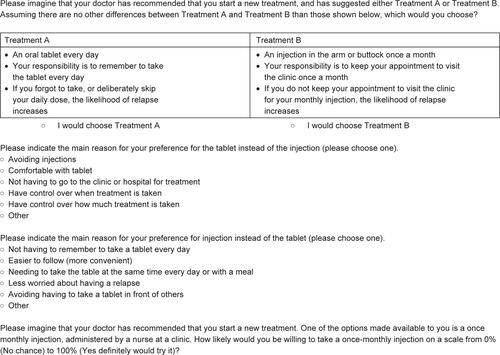Abstract
Objective
This study seeks to quantify the treatment goals of people recently diagnosed with schizophrenia and explore their impact on treatment plan.
Methods
People aged 18–35 years with a confirmed diagnosis of schizophrenia within the past 5 years were surveyed in the UK, Germany, and Italy. Treatment goals were assessed via a validated best–worst scaling instrument, where participants evaluated subsets of 13 possible treatment goals identified using a balanced incomplete block design. Participants identified the most and least important goals within each task. Data were also collected on current treatment and preference for daily oral versus long-acting injectable (LAI) treatment. Hierarchical Bayes was used to identify preference weights for the goals, and latent class analysis was used to identify segments of people with similar goals. The segments were compared with the current treatment and preference for oral versus LAI treatment.
Results
Across 100 participants, the average age was 26 years, 75% were male and 50% were diagnosed within 2 years ago. Overall, preferences were most favorable for reduced disease symptoms, think clearly, reduced hospitalizations, reduced anxiety, and take care of self. A total of 61% preferred oral medication and 39% LAI. Two groups were identified with different treatment goals; 50% of participants emphasized clinical goals, including reduced disease symptoms (preference weight =19.7%), reduced hospitalizations (15.5%), and reduced anxiety (10.5%). The other 50% emphasized functional goals, including improved relationships with family/friends (11.4%), increased interest in work (10.6%), experiencing a fuller range of emotions (8.4%), and ability to socialize (7.5%). Those emphasizing functional goals were more likely to be on LAI (44% versus 26%; p=0.059) and preferred LAI (46% versus 32%; p=0.151).
Conclusions
People with recent-onset schizophrenia may focus more on clinical goals or functional goals, a discussion of which may help facilitate patient engagement.
Supplementary materials
Acknowledgments
The authors gratefully acknowledge the participating clinical centers: Ospedale San Gerardo di Monza (Italy) with Principal Investigator (PI) Prof Massimo Clerici, Azienda Ospedaliera “Sant’Andrea”di Roma (Italy) with PI Prof Paolo Girardi, Vivantes Klinikum am Urban – Berlin (Germany) with PI Dr Karolina Leopold, Cambridgeshire and Peterborough Foundation Trust (UK) with PI Prof Jesús Pérez and Leicestershire Partnership NHS Trust (UK) with PI Dr Debasis Das. We also thank Kaitlan Amos, BS, for her assistance in survey programming and statistical analysis. An abstract of this paper was presented at the 2017 30th European College of Neuropsychopharmacology (ECNP) Congress, 2–5 September 2017, as a poster presentation. This work was supported by Otsuka Pharmaceutical Europe Ltd. and H. Lundbeck A/S.
Disclosure
KB provides consulting services to Otsuka Pharmaceutical Europe Ltd and H. Lundbeck A/S. JFPB advises ORS Health and has received travel expenses from H. Lundbeck A/S/Otsuka Pharmaceutical Europe Ltd. SH has received speaker honoraria and/or participated in clinical trials supported by Janssen-Cilag, Eli Lilly, Sanofi-Aventis, Otsuka Pharmaceutical Europe Ltd, H. Lundbeck A/S and Johnson & Johnson, Pfizer, Bristol-Myers-Squibb, AstraZeneca, Novartis, Servier, Pierre Fabre, Organon, Roche and Merck, Teva, and Janssen. PS and AGN are employees of H. Lundbeck A/S. JSC, EC, and AJL are employees of Otsuka Pharmaceutical Europe Ltd. The authors report no other conflicts of interest in this work.


